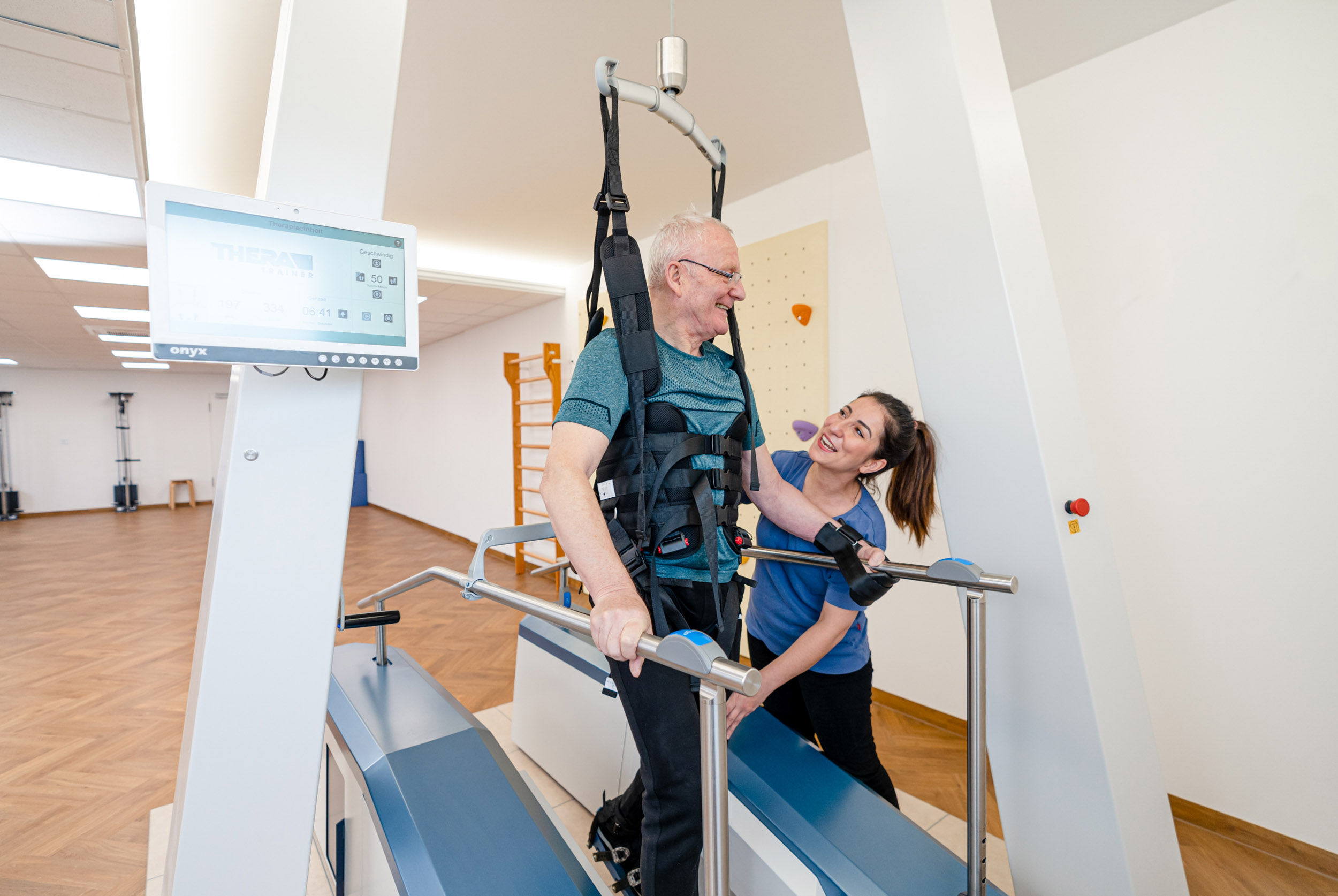
THERAPY-Magazin
End-effector gait training as the key to mobility
A new multi-centre study confirms that end-effector gait training significantly improves mobility in stroke patients. Learn how it compares to exoskeletons and standard therapy in post-stroke rehabilitation.

Jakob Tiebel
Health Business Consultant
Multi-centre study confirms promising results compared to conventional training and investigates the influence of different robotic devices on gait rehabilitation after stroke.
Robot-assisted gait training is proving to be the key to regaining mobility. A new study carried out in eight Italian rehabilitation centres confirms its promising effects compared to conventional therapy. In particular, therapy with end-effector systems has been shown to be superior in significantly improving walking speed in patients in the subacute stage. There is still a lot of potential for this scientifically established and proven technology to revolutionise stroke rehabilitation.
Walking disorders are a serious complication of a stroke – more than 75% of those affected lose the ability to walk. This has far-reaching effects on quality of life, autonomy and social participation. One of the main goals of neurological rehabilitation after a stroke is therefore restoring walking ability through targeted gait training. Intensive, repetitive and task-orientated training approaches have proven to be effective. Robot-assisted training plays a key role here, and research to increase the effectiveness of treatment and reduce the workload for therapists is ongoing.
Walking disorders are a serious complication of a stroke – more than 75% of those affected lose the ability to walk. This has far-reaching effects on quality of life, autonomy and social participation. One of the main goals of neurological rehabilitation after a stroke is therefore restoring walking ability through targeted gait training. Intensive, repetitive and task-orientated training approaches have proven to be effective. Robot-assisted training plays a key role here, and research to increase the effectiveness of treatment and reduce the workload for therapists is ongoing.
Robot-assisted training
The available robot-assisted devices can be divided into end-effector systems and exoskeletons. End-effector systems have limited contact with the body, while exoskeletons are orthotic systems that electromechanically simulate human walking movements. There is still interest in investigating the specific effects of different robot-assisted therapy devices on gait rehabilitation after a stroke. Some studies have already demonstrated the advantages of end-effector systems over exoskeletons.
The available robot-assisted devices can be divided into end-effector systems and exoskeletons. End-effector systems have limited contact with the body, while exoskeletons are orthotic systems that electromechanically simulate human walking movements. There is still interest in investigating the specific effects of different robot-assisted therapy devices on gait rehabilitation after a stroke. Some studies have already demonstrated the advantages of end-effector systems over exoskeletons.
The study once again underscores the potential of robot-assisted gait training as an effective rehabilitation strategy after a stroke and confirms the advantages of the end-effector system over exoskeletons.
Study design and objectives
This study, conducted across eight Italian rehabilitation centres, compared the clinical effects of robot-assisted gait training with conventional training in patients in the subacute stage after a stroke. The main focus was on improvement in walking speed as measured by the 10-metre walk test. The study compared the effects of end-effector systems versus exoskeletons in a subgroup comparison.
This study, conducted across eight Italian rehabilitation centres, compared the clinical effects of robot-assisted gait training with conventional training in patients in the subacute stage after a stroke. The main focus was on improvement in walking speed as measured by the 10-metre walk test. The study compared the effects of end-effector systems versus exoskeletons in a subgroup comparison.
Results
The results showed significant improvements in walking speed, endurance, balance and daily living activities in the group that received robot-assisted training compared to the conventional group. End-effector systems in particular proved to be more promising in terms of walking speed. Although further research is needed, the results suggest that people in the subacute stage after a stroke benefit significantly from robotic end-effector gait training.
The results showed significant improvements in walking speed, endurance, balance and daily living activities in the group that received robot-assisted training compared to the conventional group. End-effector systems in particular proved to be more promising in terms of walking speed. Although further research is needed, the results suggest that people in the subacute stage after a stroke benefit significantly from robotic end-effector gait training.
Conclusions
The study once again underscores the potential of robot-assisted gait training as an effective rehabilitation strategy after a stroke and confirms the advantages of the end-effector system over exoskeletons. Future research should focus on larger, controlled studies to clarify optimal training protocols for maximum efficiency.
The study once again underscores the potential of robot-assisted gait training as an effective rehabilitation strategy after a stroke and confirms the advantages of the end-effector system over exoskeletons. Future research should focus on larger, controlled studies to clarify optimal training protocols for maximum efficiency.
Ambulante Rehabilitation
Fachkreise
Gait
lyra
Science
Stationäre Rehabilitation
THERAPY 2024-I
THERAPY Magazine

Jakob Tiebel
Health Business Consultant
Jakob Tiebel is OT and studied applied psychology with a focus on health economics. He has clinical expertise from his previous therapeutic work in neurorehabilitation. He conducts research and publishes on the theory-practice transfer in neurorehabilitation and is the owner of an agency for digital health marketing.
References:
- Pournajaf S, Calabrò RS, Naro A, Goffredo M, Aprile I, Tamburella F, Filoni S, Waldner A, Mazzoleni S, Focacci A, Ferraro F, Bonaiuti D, Franceschini M, TreadStroke Group. Robotic versus Conventional Overground Gait Training in Subacute Stroke Survivors: A Multicenter Controlled Clinical Trial. J Clin Med. 2023 Jan 5;12(2):439. doi: 10.3390/jcm12020439. PMID: 36675371; PMCID: PMC9861649.
Related contents
Find related exciting contents in our media library.
This is not what you are searching for? Knowledge
Meet our specialists.
Are you interested in our solutions? Schedule a meeting with a Consultant to talk through your strategy and understand how TEHRA-Trainer can help you to advance rehabilitation.